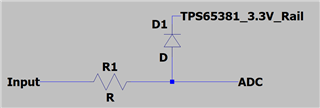In our design we have diode clamps up to 5 volt and 3.3V rails that are supplied from the TPS65381. For example, on a sensor input we don't want the voltage to go much higher than 3.3V so we have a diode up to 3.3V rail to clamp the sensor input to a max of ~4V. I would like to know how the TPS65381 will handle this extra current. If there is a high amount of current being sunk into the rail will the TPS sink the extra to ground, back to VBATP, or will it not handle the extra current and the voltage on the rail will increase leading to an overvoltage condition?
I could not find the answer in the datasheet, any help is appreciated,
Thanks


